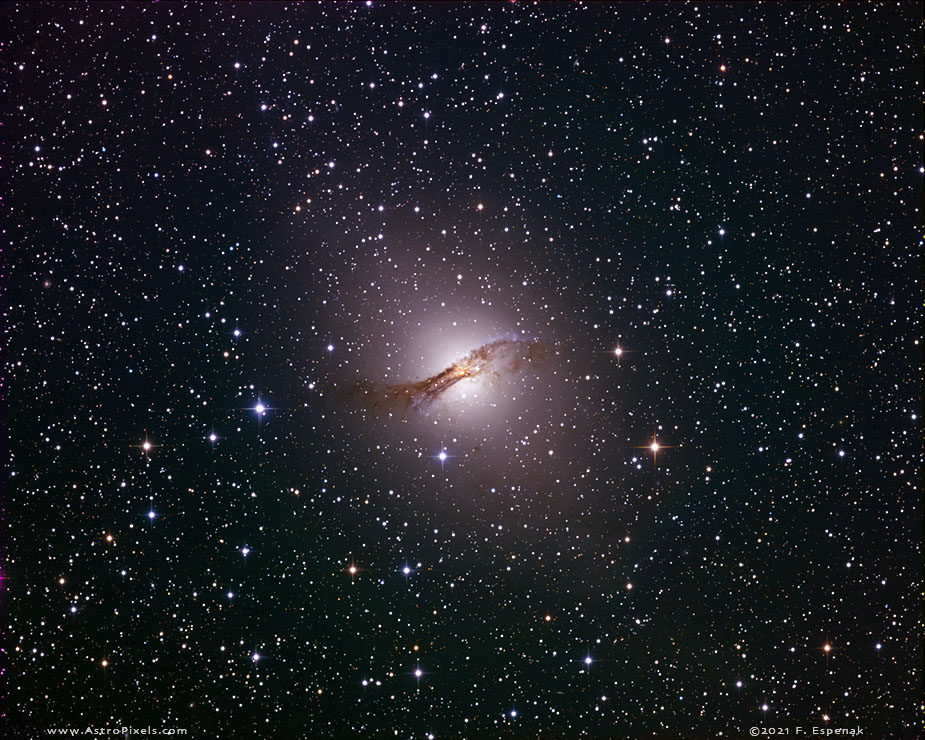NGC 5128 (Centaurus A)
NGC 5128 is a huge elliptical galaxy in the constellation Centaurus. At a distance of 10-16 million light years, NGC 5128 is one of the closest radio galaxies to Earth, so its active galactic nucleus has been extensively studied by professional astronomers. The galaxy is also the fifth-brightest in the sky. It was discovered in 1826 by Scottish astronomer James Dunlop from his home in Parramatta, in New South Wales, Australia.
The center of the galaxy contains a supermassive black hole with a mass of 55 million solar masses, which ejects a relativistic jet that is responsible for emissions in the X-ray and radio wavelengths. By taking radio observations of the jet separated by a decade, astronomers have determined that the inner parts of the jet are moving at about half of the speed of light. X-rays are produced farther out as the jet collides with surrounding gases, resulting in the creation of highly energetic particles. The X-ray jets of Centaurus A are thousands of light-years long, while the radio jets are over a million light-years long.
Like other starburst galaxies, a collision is suspected to be responsible for the intense burst of star formation. Models have suggested that Centaurus A was a large elliptical galaxy that collided and merged with a smaller spiral galaxy. The galaxy Centaurus A has for years been under particular interest by astronomers for being a possible merger of an elliptical galaxy, and a spiral galaxy. While spiral galaxies colliding with spiral galaxies is relatively common, the affects of an elliptical and a spiral collision are not fully known. See Wikipedia for much more information.
Technical Details
- Object: NGC 5128
- Other Names: Centaurus A, Caldwell 77
- Object Type: giant elliptical galaxy
- Object Data: Apparent Magnitude = 6.8, Angular Size = 25.7 × 20.0 arc-minutes
- Object Position (Equinox 2000): RA= 13h 25m, Dec= -43° 01´, Constellation = Centaurus
- Date: 2021 Jan 10-12
- Location: Chile Remote Observatory, Observatorio El Sauce, Chile
- Partnership: Operated in partnership with David Churchill
- Telescope: Planewave CDK-17 (with Focal Reducer: f/4.5; FL = 1945mm)
- Camera: QHY 16200A with Integral 7-position Filter Wheel
- Mount: Astro-Physics 1600GTO
- Guider: Agena Starguide II / SBIG STi
- Field of View: 38.9' x 58.3' at 0.64 arc-sec/pixel
- Sub-Exposures: Astronomik Filters
- Luminance: 24 x 10 min = 240 min
- Red: 7 x 10 min = 70 min
- Green: 6 x 10 min = 600 min
- Blue: 15 x 10 min = 150 min - Total Exposure: 8h 40m
- File Name: NGC5128-CDK21-C01w.jpg
- Field of View: 38.9 x 58.3 arc-minutes at 0.64 arc-sec/pixel
- Original Image Size: 3630 x 4540 pixels (16.5 MP); 12.1" x 15.1" @ 300 dpi
- Data Acquisition: David Churchill
- Image Processing: Fred Espenak
- Maxim DL: Image Calibration, Stacking, Digital Development Processing
- Adobe Camera Raw: Noise Reduction
- Photoshop CC: Curves, Levels, Vibrance - Copyright: Fred Espenak
